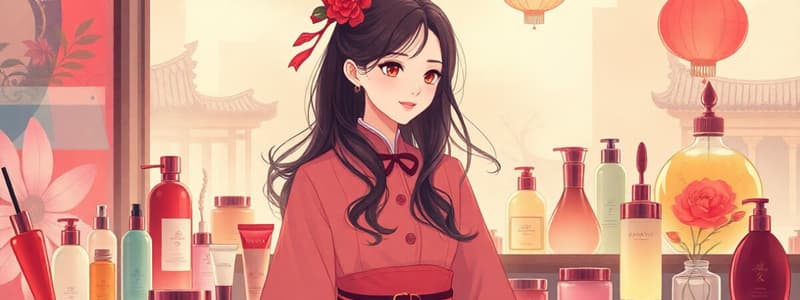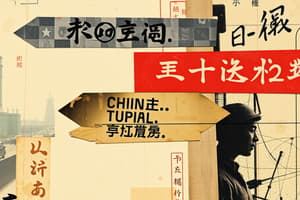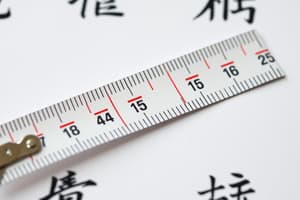Podcast
Questions and Answers
Which factor most significantly contributed to the increasing demand for premium beauty and skincare products among Chinese consumers?
Which factor most significantly contributed to the increasing demand for premium beauty and skincare products among Chinese consumers?
- Government policies promoting the consumption of luxury goods.
- A decline in the quality of domestically produced beauty products.
- A significant rise in the disposable income of Chinese individuals. (correct)
- Increased exposure to Western media and advertising.
What was the primary challenge Yue Sai faced after being acquired by Coty?
What was the primary challenge Yue Sai faced after being acquired by Coty?
- Resistance from consumers to accept a foreign-owned cosmetic brand.
- Difficulty in maintaining consistent product quality across different regions.
- A shift in focus towards distribution at the expense of brand building, leading to a loss of brand relevance. (correct)
- Inability to compete with lower-priced domestic brands.
How did L'Oréal initially attempt to reposition Yue Sai after acquiring the brand?
How did L'Oréal initially attempt to reposition Yue Sai after acquiring the brand?
- By targeting a younger demographic with lower-priced products.
- By emphasizing the brand's Western origins and heritage.
- By discontinuing the brand in major cities and focusing on rural markets.
- By employing strategies similar to L'Oréal Paris, focusing on technology and using actresses and models in advertising. (correct)
What strategic shift did LPD implement after taking over Yue Sai in 2006?
What strategic shift did LPD implement after taking over Yue Sai in 2006?
What critical decision did Yue Sai need to make regarding its brand identity in relation to L'Oréal?
What critical decision did Yue Sai need to make regarding its brand identity in relation to L'Oréal?
In the context of distribution channels in China, what differentiates a 'Tier 2' city from a 'Tier 1' city?
In the context of distribution channels in China, what differentiates a 'Tier 2' city from a 'Tier 1' city?
What was a significant barrier that Yue Sai had to overcome when it was first established in 1992?
What was a significant barrier that Yue Sai had to overcome when it was first established in 1992?
What internal challenge did Yue Sai face that hindered its ability to improve sales, even after an initial market boom?
What internal challenge did Yue Sai face that hindered its ability to improve sales, even after an initial market boom?
How did the perception of makeup among Chinese women influence the cosmetic market in China during Yue Sai's early years?
How did the perception of makeup among Chinese women influence the cosmetic market in China during Yue Sai's early years?
In the context of marketing mix decisions for Yue Sai, what unique challenge did the brand face regarding social media?
In the context of marketing mix decisions for Yue Sai, what unique challenge did the brand face regarding social media?
What was the original aim of Madam Yue-Sai when she launched her cosmetic brand in China?
What was the original aim of Madam Yue-Sai when she launched her cosmetic brand in China?
What potential risk did Yue Sai face by explicitly highlighting L'Oréal's ownership in its branding?
What potential risk did Yue Sai face by explicitly highlighting L'Oréal's ownership in its branding?
What was the primary impact of internet-based retailing on existing distribution channels in the Chinese cosmetic market?
What was the primary impact of internet-based retailing on existing distribution channels in the Chinese cosmetic market?
What initiative did Yue Sai implement to secure widespread distribution of its products in department stores across China during its early years?
What initiative did Yue Sai implement to secure widespread distribution of its products in department stores across China during its early years?
What distinguishes Class 2 department stores from other retail channels in China's cosmetic market?
What distinguishes Class 2 department stores from other retail channels in China's cosmetic market?
How did Yue Sai's distribution strategy evolve after being acquired by Coty?
How did Yue Sai's distribution strategy evolve after being acquired by Coty?
According to the information provided, what was a key reason for Yue Sai's uncertain business model?
According to the information provided, what was a key reason for Yue Sai's uncertain business model?
What factor primarily caused the shift of Chinese consumers towards Western brands between 1990 and 2000?
What factor primarily caused the shift of Chinese consumers towards Western brands between 1990 and 2000?
What was one of the primary objectives of L'Oréal's investment in a major television and print advertising campaign featuring Chinese supermodel Du Juan?
What was one of the primary objectives of L'Oréal's investment in a major television and print advertising campaign featuring Chinese supermodel Du Juan?
Based on the information provided, what can be inferred about the nature of competition in the Chinese beauty and skincare market?
Based on the information provided, what can be inferred about the nature of competition in the Chinese beauty and skincare market?
Flashcards
P&G in China
P&G in China
First multinational to enter China's beauty market (1989).
Cosmetic Retail Tiers
Cosmetic Retail Tiers
Tier 1 stores carry premium brands, tier 3 are small local cosmetics stores.
Chinese Confidence (1990-2000)
Chinese Confidence (1990-2000)
Consumers drawn to Western Brands, brand/skincare knowledge increased
L'Oréal in China
L'Oréal in China
Signup and view all the flashcards
Yue Sai
Yue Sai
Signup and view all the flashcards
Yue Sai & Coty
Yue Sai & Coty
Signup and view all the flashcards
Turn Around Yue Sai
Turn Around Yue Sai
Signup and view all the flashcards
Yue Sai Decisions
Yue Sai Decisions
Signup and view all the flashcards
LPD Meaning
LPD Meaning
Signup and view all the flashcards
Study Notes
- China has a population of 1.3 billion and is the second-largest economy in terms of GDP
- Chinese consumers now want premium beauty and skincare products due to increased disposable income
Chinese Cosmetic Market
- P&G was the first multinational corporation to enter China's beauty and skincare market in 1989 with Oley
- In 2010, P&G, L'Oréal, Shiseido, Unilever, and Amway were the top 5 beauty and skincare companies
Distribution Channels
- Class-1 stores carry brands such as Lancome, Chanel, and Dior
- Class-2 department stores consist of beauty store chains like Watsons and Manning which employ beauty assistants who can sell any brand
- Tier-3 channel consists of small local cosmetic stores without beauty assistants
- Internet retailing impacts existing channels
Cosmetic Product Attitudes
- Cosmetics were non-existent in China for decades
- YUE SAI, founded in 1992, first educated Chinese consumers on beauty products/routines
- Makeup products accounted for 10-15% of the beauty products sold
- Chinese women viewed makeup as superficial and harmful and considered China as primarily a skincare market
Rising Chinese Confidence
- Overall Chinese consumers in tier-1 cities became more sophisticated about brands and products in beauty and skincare categories
- Between 1990-2000, Chinese consumers were drawn to Western brands
L'Oreal in China
- L'Oréal is the second-largest beauty and skincare player after P&G and is the N.1 luxury segment
- Luxury Product Division (LPD) includes brands like Lancome, Giorgio Armani
- Consumer Product Division (CPD) includes L'Oréal Paris, Garnier.
About Yue Sai
- First modern cosmetic brand in China, founded in 1992.
- Founder Madam Yue-Sai wrote a book about makeup to promote the brand which became the first published in China
- Yue Sai secured distribution in department stores, trained beauty advisors, and the lipstick red became an icon
- Coty acquired Yue Sai in 1996, focusing on distribution to reach more cities rather than less premium cosmetic stores
- By 1998, Yue Sai became the No.1 luxury cosmetic brand in China
- Coty pushed distribution rather than branding, causing Yue Sai to lose its relevance
- L'Oréal put Yue Sai into its Consumer Product Division due to Yue Sai acquiring wide distribution, strong sales, factories, and R&D under Coty
- Since Yue Sai had wide distribution, it went under CPD and CDP tried to apply the same marketing strategy it applied to L'Oréal Paris
- Consumers associated the brand with being for older customers and sales dropping and it was unclear how it fitted into L'Oréal's brand portfolio
- Yue Sai was priced slightly below L'Oréal Paris
- The brand communication focused on technology, with actresses and models, like for L'Oréal Paris
LPD Yue Sai
- Yue Sai was transferred to the LPD in 2006 which promoted Yue Sai featuring a Taiwanese actress
- LPD repositioned Yue Sai as “the first brand to stand for Chinese women's beauty"
- The idea was built that modern Chinese women were changing, becoming proud, self-confident, and had a clear vision of their future
- To communicate Yue Sai's positioning, L'Oréal invested in a major television and print advertising campaign featuring Chinese supermodel Du Juan
- LPD increased Yue Sai's price and entered new distribution channels like Sephora while pushing for better deals with distributors to enter more cosmetic stores
- While the company did this, many foreign premium brands where entering the Chinese market, and department stores pushed Yue Sai away
Turn Around Yue Sai
- Alexis Perakis-Valat became the new CEO of L'Oréal China in 2010
- Yue Sai, wasn't improving its sales, and internally employees weren't motivated
- The right value proposition was to be determined
- Yue Sai was not perceived as aspirational like Lancome, Estée Lauder or Shiseido due to having an uncertain business model, an aging clientele and unclear positioning
- Four major decisions had to be made:
- Keep its new lifestyle positioning as the brand for “confident, modern Chinese women"
- To be positioned as a Chinese Luxury Icon
- Adopt a more affordable value proposition
- Try something different
- The decision was made on which associations with L'Oréal Group to make explicit to consumers by becoming a sub-brand or by acknowledging L'Orèal Ownership
Marketing Mix Decisions
- Focus was placed on adv and promotions
- Key decisions were to continue or change the current TV and press campaign
Pricing and Distribution
- Yue Sai pricing was determined within the L'Oréal brand portfolio in China to select the right distribution channels
- Right value proposition
- Product Branding
- No social media because they were still not employed, website adv
- Decision distribution: department stores
- Pricing: up L'Oréal Paris and below Lancome
Studying That Suits You
Use AI to generate personalized quizzes and flashcards to suit your learning preferences.




